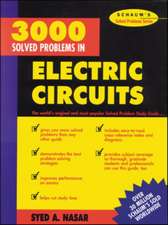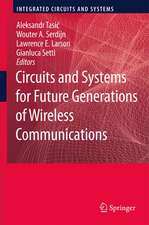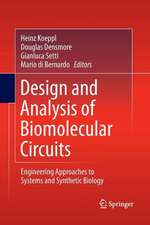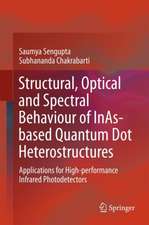Adapted Compressed Sensing for Effective Hardware Implementations: A Design Flow for Signal-Level Optimization of Compressed Sensing Stages
Autor Mauro Mangia, Fabio Pareschi, Valerio Cambareri, Riccardo Rovatti, Gianluca Settien Limba Engleză Hardback – 24 iul 2017
| Toate formatele și edițiile | Preț | Express |
|---|---|---|
| Paperback (1) | 562.85 lei 38-44 zile | |
| Springer International Publishing – 7 aug 2018 | 562.85 lei 38-44 zile | |
| Hardback (1) | 648.56 lei 6-8 săpt. | |
| Springer International Publishing – 24 iul 2017 | 648.56 lei 6-8 săpt. |
Preț: 648.56 lei
Preț vechi: 763.01 lei
-15% Nou
Puncte Express: 973
Preț estimativ în valută:
124.12€ • 129.24$ • 104.90£
124.12€ • 129.24$ • 104.90£
Carte tipărită la comandă
Livrare economică 10-24 martie
Preluare comenzi: 021 569.72.76
Specificații
ISBN-13: 9783319613727
ISBN-10: 3319613723
Pagini: 320
Ilustrații: XIV, 319 p. 180 illus., 142 illus. in color.
Dimensiuni: 155 x 235 mm
Greutate: 0.64 kg
Ediția:1st ed. 2018
Editura: Springer International Publishing
Colecția Springer
Locul publicării:Cham, Switzerland
ISBN-10: 3319613723
Pagini: 320
Ilustrații: XIV, 319 p. 180 illus., 142 illus. in color.
Dimensiuni: 155 x 235 mm
Greutate: 0.64 kg
Ediția:1st ed. 2018
Editura: Springer International Publishing
Colecția Springer
Locul publicării:Cham, Switzerland
Cuprins
Chapter 1. Introduction to Compressed Sensing: Fundamentals and Guarantees.- Chapter 2.How (Well) Compressed Sensing Works in Practice.- Chapter 3. From Universal to Adapted Acquisition: Rake that Signal!.- Chapter 4.The Rakeness Problem with Implementation and Complexity Constraints.- Chapter 5.Generating Raking Matrices: a Fascinating Second-Order Problem.- Chapter 6.Architectures for Compressed Sensing.- Chapter 7.Analog-to-information Conversion.- Chapter 8.Low-complexity Biosignal Compression using Compressed Sensing.- Chapter 9.Security at the analog-to-information interface using Compressed Sensing.
Notă biografică
Mauro Mangia received the B.Sc., M.Sc. in Electronic Engineering, Ph.D. degree in information technology from the University of Bologna (Bologna, Italy) respectively in 2005, 2009 and 2013. He is currently a Postdoc Researcher in the statistical signal processing group of ARCES - University of Bologna. In 2009 and 2012 he was a visiting Ph.D. student at the Ècole Polytechnique Fédérale de Lausanne (EPFL). His research interests are in nonlinear systems, compressed sensing, ultra-wideband systems, and system biology. He was recipient of the 2013 IEEE CAS Society Guillemin-Cauer Award and best student paper award at ISCAS2011.
Fabio Pareschi received the Dr. Eng. degree (with honours) in Electronic Engineering from University of Ferrara, Italy, in 2001, and the Ph.D. in Information Technology under the European Doctorate Project (EDITH) from University of Bologna, Italy, in 2007. He is currently an Assistant Professor in the Department of Engineering (ENDIF), University of Ferrara. He is also a faculty member of ARCES – University of Bologna, Italy. He served as Associate Editor for the IEEE Transactions on Circuits and Systems – Part II (2010–2013). His research activity focuses on analog and mixed-mode electronic circuit design, statistical signal processing, random number generation and testing, and electromagnetic compatibility. He was recipient of the best paper award at ECCTD 2005 and the best student paper award at EMC Zurich 2005.
Valerio Cambareri received the B.Sc., M.Sc., and Ph.D. degrees in Electronic Engineering from the University of Bologna (Bologna, Italy), respectively in 2008, 2011, and 2015. In 2014 he was a Visiting Researcher in the Integrated Imagers group of IMEC (Leuven, Belgium). From May 2015 to June 2017 he was a Postdoctoral Researcher in the Image and Signal Processing Group of ICTEAM/ELEN, Université catholique de Louvain (Louvain-la-Neuve, Belgium). In June 2017,he joined SoftKinetic International SA/NV (Brussels, Belgium). His current research interests focus on signal processing theory and methods, compressed sensing, computational imaging, and depth sensing technologies.
Riccardo Rovatti received a Dr. Eng. Degree (with honors) in Electronic engineering and a PhD. Degree in Electronic Engineering and Computer Science from the University of Bologna, Bologna in 1992 and in 1996, respectively, for his contribution to the study of fuzzy systems. He is currently a Professor of Electronics and Signal Processing at the University of Bologna and a permanent faculty member of ARCES, the Advanced Research Center on Electronic Systems for Information and Communication Technologies of the University of Bologna. He is the author of more than 300 technical contribution to international conferences and journal and of three volumes. His research interests currently focus on non-linear and statistical signal processing for, or by means of, electronic systems.
Dr. Rovatti is co-recipient of the 2004 IEEE CAS Society Darlington Award, of the 2013 IEEE CAS Society Guillemin-Cauer Award, as well as of the best paper award at ECCTD2005, and the best student paper award at EMCZurich2005 and at ISCAS2011. He was Associate Editor for the IEEE Transactions on Circuits and Systems - Part I (2006-2007) and Guest Editor of the IEEE Journal on Selected and Emerging Topics in Circuits and Systems (Special issue on ``Circuits, Systems and Algorithms for Compressive Sensing'', September 2012) and of the Proceedings of the IEEE (Special issue on "Applications of Nonlinear Dynamics to Electronic and Information Engineering'', May 2002). He is a Distinguished Lecturer of the IEEE CAS Society (2017-2018) and is a Fellow of the IEEE (class of 2012).
Gianluca Setti received a Dr. Eng. degree (with honors) in Electronic Engineering and a Ph.D. degree in Electronic Engineering and ComputerScience from the University of Bologna, Bologna in 1992 and in 1997, respectively, for his contribution to the study of neural networks and chaotic systems. From May 1994 to July 1995 he was with the Laboratory of Nonlinear Systems (LANOS) of the Swiss Federal Institute of Technology in Lausanne (EPFL) as visiting researcher. Since 1997 he has been with the School of Engineering at the University of Ferrara, Italy, where he is currently a Professor of Circuit Theory and Analog Electronics. He held several position as Visiting Professor/Scientist at EPFL (2002, 2005), UCSD (2004), IBM T. J. Watson Laboratories (2004, 2007) and at the University of Washington in Seattle (2008, 2010) and is also a permanent faculty member of ARCES, University of Bologna. His research interests include nonlinear circuits, recurrent neural networks, implementation and application of chaotic circuits and systems, electromagnetic compatibility, statistical signal processing and compressed sensing. Dr. Setti received the 2013 IEEE CAS Society Meritorious Service Award and co-recipient of the 2004 IEEE CAS Society Darlington Award, of the 2013 IEEE CAS Society Guillemin-Cauer Award, as well as of the best paper award at ECCTD2005, and the best student paper award at EMCZurich2005 and at ISCAS2011. He held several editorial positions and served, in particular, as the Editor-in-Chief for the IEEE Transactions on Circuits and Systems - Part II (2006-2007) and of the IEEE Transactions on Circuits and Systems - Part I (2008-2009) and as member for the Editorial Board of IEEE Access and the Proceedings of the IEEE, as well as Guest Editor of the IEEE Journal on Selected and Emerging Topics in Circuits and Systems (Special issue on ``Circuits, Systems and Algorithms for Compressive Sensing'', September 2012) and of the Proceedings of the IEEE (Special issue on ``Applications of Nonlinear Dynamics to Electronic and Information Engineering'', May 2002). Dr. Setti served/will serve as Technical Program Co-Chair of ISCAS2007, ISCAS2008, ICECS2012, BioCAS2013 as well as the General Co-Chair of NOLTA2006 and ISCAS2018. He was Distinguished Lecturer of the IEEE CAS Society (2004-2005 and 2015-2016), a member of its Board of Governors (2005-2008), and he served as the 2010 President of CASS. He held several other volunteer positions for the IEEE and in 2013-2014 he was the first non North-American Vice President of the IEEE for Publication Services and Products and a member of the IEEE Board of Directors. He is a Fellow of the IEEE (class of 2006).
Fabio Pareschi received the Dr. Eng. degree (with honours) in Electronic Engineering from University of Ferrara, Italy, in 2001, and the Ph.D. in Information Technology under the European Doctorate Project (EDITH) from University of Bologna, Italy, in 2007. He is currently an Assistant Professor in the Department of Engineering (ENDIF), University of Ferrara. He is also a faculty member of ARCES – University of Bologna, Italy. He served as Associate Editor for the IEEE Transactions on Circuits and Systems – Part II (2010–2013). His research activity focuses on analog and mixed-mode electronic circuit design, statistical signal processing, random number generation and testing, and electromagnetic compatibility. He was recipient of the best paper award at ECCTD 2005 and the best student paper award at EMC Zurich 2005.
Valerio Cambareri received the B.Sc., M.Sc., and Ph.D. degrees in Electronic Engineering from the University of Bologna (Bologna, Italy), respectively in 2008, 2011, and 2015. In 2014 he was a Visiting Researcher in the Integrated Imagers group of IMEC (Leuven, Belgium). From May 2015 to June 2017 he was a Postdoctoral Researcher in the Image and Signal Processing Group of ICTEAM/ELEN, Université catholique de Louvain (Louvain-la-Neuve, Belgium). In June 2017,he joined SoftKinetic International SA/NV (Brussels, Belgium). His current research interests focus on signal processing theory and methods, compressed sensing, computational imaging, and depth sensing technologies.
Riccardo Rovatti received a Dr. Eng. Degree (with honors) in Electronic engineering and a PhD. Degree in Electronic Engineering and Computer Science from the University of Bologna, Bologna in 1992 and in 1996, respectively, for his contribution to the study of fuzzy systems. He is currently a Professor of Electronics and Signal Processing at the University of Bologna and a permanent faculty member of ARCES, the Advanced Research Center on Electronic Systems for Information and Communication Technologies of the University of Bologna. He is the author of more than 300 technical contribution to international conferences and journal and of three volumes. His research interests currently focus on non-linear and statistical signal processing for, or by means of, electronic systems.
Dr. Rovatti is co-recipient of the 2004 IEEE CAS Society Darlington Award, of the 2013 IEEE CAS Society Guillemin-Cauer Award, as well as of the best paper award at ECCTD2005, and the best student paper award at EMCZurich2005 and at ISCAS2011. He was Associate Editor for the IEEE Transactions on Circuits and Systems - Part I (2006-2007) and Guest Editor of the IEEE Journal on Selected and Emerging Topics in Circuits and Systems (Special issue on ``Circuits, Systems and Algorithms for Compressive Sensing'', September 2012) and of the Proceedings of the IEEE (Special issue on "Applications of Nonlinear Dynamics to Electronic and Information Engineering'', May 2002). He is a Distinguished Lecturer of the IEEE CAS Society (2017-2018) and is a Fellow of the IEEE (class of 2012).
Gianluca Setti received a Dr. Eng. degree (with honors) in Electronic Engineering and a Ph.D. degree in Electronic Engineering and ComputerScience from the University of Bologna, Bologna in 1992 and in 1997, respectively, for his contribution to the study of neural networks and chaotic systems. From May 1994 to July 1995 he was with the Laboratory of Nonlinear Systems (LANOS) of the Swiss Federal Institute of Technology in Lausanne (EPFL) as visiting researcher. Since 1997 he has been with the School of Engineering at the University of Ferrara, Italy, where he is currently a Professor of Circuit Theory and Analog Electronics. He held several position as Visiting Professor/Scientist at EPFL (2002, 2005), UCSD (2004), IBM T. J. Watson Laboratories (2004, 2007) and at the University of Washington in Seattle (2008, 2010) and is also a permanent faculty member of ARCES, University of Bologna. His research interests include nonlinear circuits, recurrent neural networks, implementation and application of chaotic circuits and systems, electromagnetic compatibility, statistical signal processing and compressed sensing. Dr. Setti received the 2013 IEEE CAS Society Meritorious Service Award and co-recipient of the 2004 IEEE CAS Society Darlington Award, of the 2013 IEEE CAS Society Guillemin-Cauer Award, as well as of the best paper award at ECCTD2005, and the best student paper award at EMCZurich2005 and at ISCAS2011. He held several editorial positions and served, in particular, as the Editor-in-Chief for the IEEE Transactions on Circuits and Systems - Part II (2006-2007) and of the IEEE Transactions on Circuits and Systems - Part I (2008-2009) and as member for the Editorial Board of IEEE Access and the Proceedings of the IEEE, as well as Guest Editor of the IEEE Journal on Selected and Emerging Topics in Circuits and Systems (Special issue on ``Circuits, Systems and Algorithms for Compressive Sensing'', September 2012) and of the Proceedings of the IEEE (Special issue on ``Applications of Nonlinear Dynamics to Electronic and Information Engineering'', May 2002). Dr. Setti served/will serve as Technical Program Co-Chair of ISCAS2007, ISCAS2008, ICECS2012, BioCAS2013 as well as the General Co-Chair of NOLTA2006 and ISCAS2018. He was Distinguished Lecturer of the IEEE CAS Society (2004-2005 and 2015-2016), a member of its Board of Governors (2005-2008), and he served as the 2010 President of CASS. He held several other volunteer positions for the IEEE and in 2013-2014 he was the first non North-American Vice President of the IEEE for Publication Services and Products and a member of the IEEE Board of Directors. He is a Fellow of the IEEE (class of 2006).
Textul de pe ultima copertă
This book describes algorithmic methods and hardware implementations that aim to help realize the promise of Compressed Sensing (CS), namely the ability to reconstruct high-dimensional signals from a properly chosen low-dimensional “portrait”. The authors describe a design flow and some low-resource physical realizations of sensing systems based on CS. They highlight the pros and cons of several design choices from a pragmatic point of view, and show how a lightweight and mild but effective form of adaptation to the target signals can be the key to consistent resource saving. The basic principle of the devised design flow can be applied to almost any CS-based sensing system, including analog-to-information converters, and has been proven to fit an extremely diverse set of applications. Many practical aspects required to put a CS-based sensing system to work are also addressed, including saturation, quantization, and leakage phenomena..
Caracteristici
Discusses the theory as necessary, but either in parallel with extremely simple examples or with reference to the performances that can be actually obtained by CS-based sensing systems Describes a design flow that can be applied to almost any signal class, and that makes CS competitive with respect to alternative options Addresses both analog and digital implementations, clarifying with which conventional systems they should be matched and what are the respective benefits. Includes supplementary material: sn.pub/extras



















